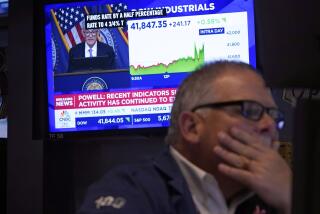Banks Expected to Follow Fedâs Move and Cut Prime Rate
WASHINGTON â Major banks are expected to cut their prime lending rate from 10.5% to 10% next week following a further easing of monetary policy by the Federal Reserve this week, according to financial analysts.
With the rates commercial banks pay for deposits and certificates of deposit coming down as a result of this and earlier Fed actions, analysts were sure banks would soon lower their prime lending rate.
The rates charged by banks on most business loans and a growing share of consumer loans, such as home equity loans, are tied to the prime.
âMoney market conditions clearly warrant a downward adjustment in the prime,â said William Sullivan, director of money market research for Dean Witter Reynolds Inc. âPrime rate cuts will be universal by the middle of next week,â he predicted.
F. Ward McCarthy of Stone & McCarthy, a Princeton, N.J., consulting firm specializing in money market analysis, agreed with Sullivanâs assessment. âMy guess is that you probably will see some prime rate cuts by the middle of next week,â he said.
With the latest Fed move, major banks are paying more than 2 percentage points less to acquire funds by issuing large CDs than they are receiving when they lend at the prime rate.
There were widespread expectations of a prime reduction when the Fed dropped the federal funds rate from 8.75% to 8.5% two weeks ago.
âIt is typical in a falling-rate environment for the spread between the prime and the cost of funds to widen,â explained McCarthy, because a wider spread boosts bank profits. âI think the banks will continue that kind of foot draggingâ since their profits have been squeezed by a variety of factors, he said.
In addition, McCarthy said, many banks need to raise new capital to meet more stringent requirements being imposed by the Fed and other bank regulators. One way to do that is to raise profits and hold the extra money as retained earnings rather than paying it out as dividends.
The Fed surprised most investors and analysts Wednesday by aggressively adding cash to the banking system at a time when the federal funds rate, the interest rate financial institutions charge each other for overnight loans, was at 8.435%, already below the 8.5% level widely assumed to be the central bankâs target.
By the end of the day Wednesday, the key federal funds rate, the level of which influences most other short-term rates set by market forces, was down to 8.125%, and most analysts decided that the Fed had eased policy another notch.
More to Read
Inside the business of entertainment
The Wide Shot brings you news, analysis and insights on everything from streaming wars to production â and what it all means for the future.
You may occasionally receive promotional content from the Los Angeles Times.










